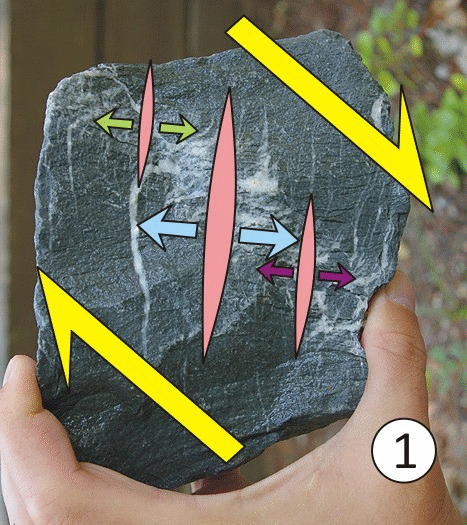24 August 2010
Tipping your tension gash
Posted by Callan Bentley
Tension gashes are small veins that open up when rocks get stretched. Often, they are arrayed en echelon with respect to other tension gashes, all oriented in the same direction. Here is a sample of tension gashes I found this summer in rip-rap (i.e., not in situ) at some building site in New England. (I forget where, but it doesn’t matter, since it’s rip-rap. Could have come from anywhere!) Check out the lovely veins of milky quartz:
We’ve seen this sort of thing before. So how does this form? It takes a series of steps. First, the rock gets sheared along some zone. Tension fractures open up oblique to that zone (as shown by the arrows here) and get filled it with mineral precipitations:
As shearing continues (with the same kinematics), these short mineral veins experience rotation (dextral, in this case) and perhaps some folding:
The more shearing you get, the more rotation and folding of the gashes:
You get the idea, right?
Here it is in summary:

I’m loving animated GIFs these days. So flippin’ cool, right?
Here’s the back side of the same sample, where you can see that a central fault has ruptured through the lovely tension gashes. It’s not as well-developed on the front side:

Poor things. It’s such a shame when ductile structures go brittle.








 Callan Bentley is Associate Professor of Geology at Piedmont Virginia Community College in Charlottesville, Virginia. He is a Fellow of the Geological Society of America. For his work on this blog, the National Association of Geoscience Teachers recognized him with the James Shea Award. He has also won the Outstanding Faculty Award from the State Council on Higher Education in Virginia, and the Biggs Award for Excellence in Geoscience Teaching from the Geoscience Education Division of the Geological Society of America. In previous years, Callan served as a contributing editor at EARTH magazine, President of the Geological Society of Washington and President the Geo2YC division of NAGT.
Callan Bentley is Associate Professor of Geology at Piedmont Virginia Community College in Charlottesville, Virginia. He is a Fellow of the Geological Society of America. For his work on this blog, the National Association of Geoscience Teachers recognized him with the James Shea Award. He has also won the Outstanding Faculty Award from the State Council on Higher Education in Virginia, and the Biggs Award for Excellence in Geoscience Teaching from the Geoscience Education Division of the Geological Society of America. In previous years, Callan served as a contributing editor at EARTH magazine, President of the Geological Society of Washington and President the Geo2YC division of NAGT.
Very cool!
Very cool animated GIF!
Nice. May I steal that animated gif for structure lectures? It’s better than my step-by-step cartoons.
Of course!
[…] illustration of rock deformation on a smaller scale: tipping your tension gash (with animation!) http://mountainbeltway.wordpress.com/2010/08/24/tipping-your-tension-gash/ (via […]
[…] https://blogs.agu.org/mountainbeltway/2010/08/24/tipping-your-tension-gash/ […]